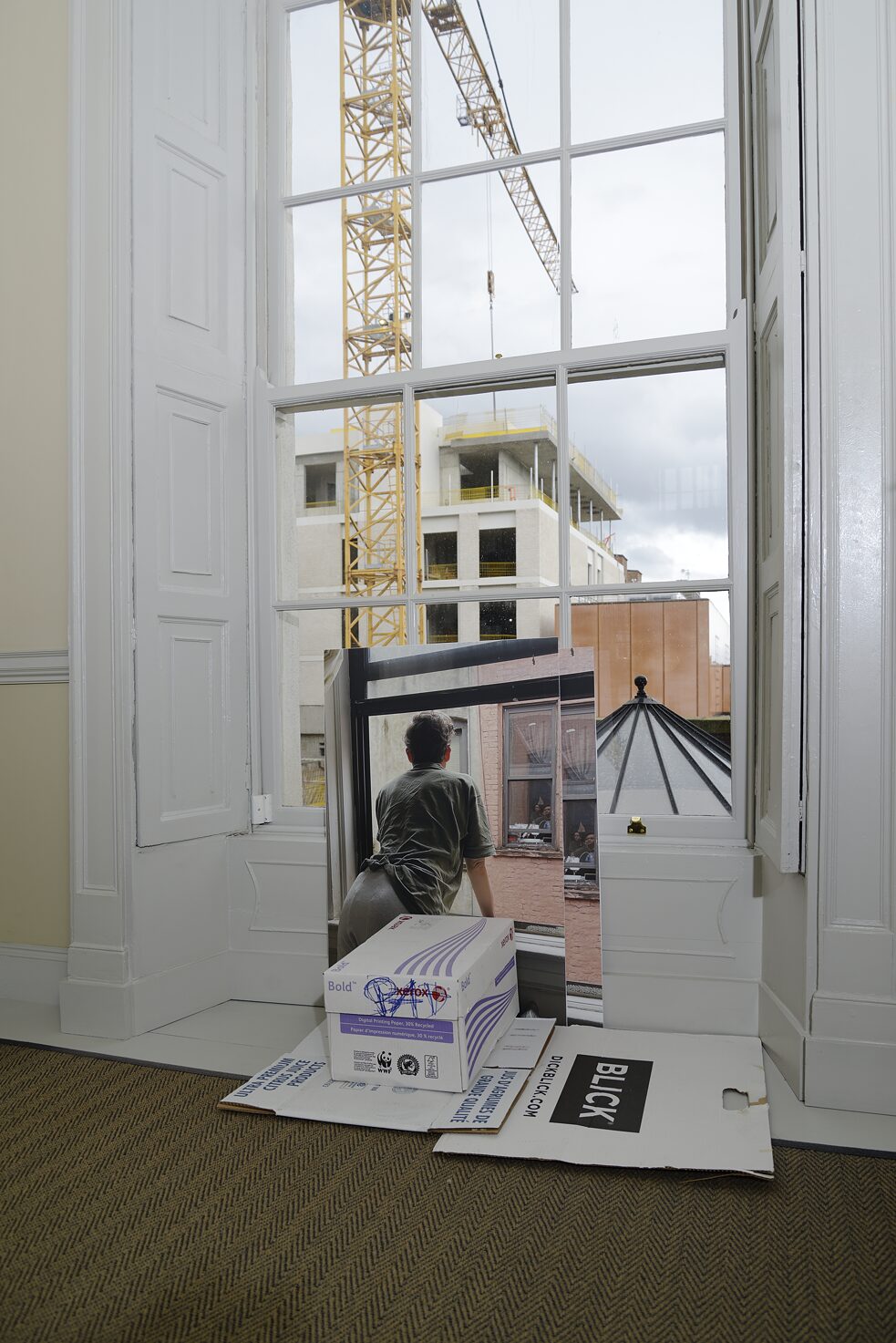Sharp Service
With works by Ella CB, Nina Nadig, Dudu Quintanilha, Eva Richardson McCrea, Lisa Strozyk, Gintaré Sokelyté and Juliet Carpenter.
29 April to 3 JuneSharp Service is the fifth exhibition in the Goethe-Institut's programme The German School. The students engage the paradigm of the filmic, whether through moving or still images, audio, or installation.
Ella CB’s Ass in Window, made in collaboration with Tobias Sashá, is a sculptural photographic assembly in four parts. Each related element is titled separately: Ass in Window Schlafzimmer Alliés, Ass in Window Fragile Imperial Livingroom, Ass in Window Kitchen and Ass in Window Bad Dick’s Blick. Together they reflect the linguistic collage created by the combination of found cardboard boxes, each appended with handwritten notes that refer to the rooms of a house – a recurring framing motif throughout Ella CB’s work.
Nina Nadig’s Great German Love / Suffer Girl (Martha xx:xx) is a series of four four-colour silkscreen prints. The series depicts stills taken from Rainer Werner Fassbinder's Martha (1978), a film portraying a woman actively committing to a sadistic and damaging marriage. The screen-grabbed film stills were first printed with a mechanically defective inkjet printer, creating the colour distortions and vertical stripes that interrupt the composition of the original film shot. Nadig then reproduced the defective inkjet prints as silkscreen prints, concluding a sequence of pictorial derivations of derivations, that both degrade and preserve the image of a damaged character.
Collaborating with Roisin Berg, Juliet Carpenter’s The Sun Is Not To Be Believed is an algorithmically driven black and white video that follows a shrouded protagonist as they undertake various tasks in a ‘Schrebergarten’ (allotment). Using the extrapolated logic of Samuel Beckett’s Quad, Berg and Carpenter construct an algorithm that modulates the frame rate of the film across its duration. The cycle repeats four times. With each permutation the machine looks forwards and backwards into its own timeline, cutting in fragments from both directions to produce a mutant temporal fissure.
Eva Richardson McCrea has made work previously around gentrification and property development in both Dublin and Frankfurt am Main. For Sharp Service McCrea presents Zeil (2022) which consists of five 16mm film stills which have been scanned, enlarged and printed. The images are double exposures shot in the Zeil shopping centre, Frankfurt am Main, in November 2021.
Video About is a recent work by Dudu Quintanilha, who graduated from the class in 2021. Filmed by a distant camera from across a courtyard, the work dispassionately records both the facade of a studio building, within which 13 performers, all art students who were Quintanilha’s colleagues in Städelschule, each ponder answers to 31 questions posed from afar. Video About is a study in the dynamics of proximity and distance, and the interrelations of individuals and institutions.
Lisa Strozyk presents interconnected drawings, metal shape sculptures, and Dough, a video work that ties the various elements together. Dough is a close study of the activity of kneading dough. The work seems to produce an ASMR-like pleasure in viewers. The textures in the video are bodily, soft and fleshy, interrupted occasionally by hard and metallic cookie cutters. Strozyk’s Shapemaker sculptures can be described as abstractly formed cookie cutters, made from stainless steel ribbon and steel wire. They connect to memories of childhood, evoking thoughts of leisure time, homeliness and family. Yet they are also sharp objects, factory made, and their further purpose serves to define shapes out of shapeless dough, and to identify specific names with this shaped dough. Shapes is a related series of drawings made over a period of time that is ongoing and will continue.
Gintaré Sokelyté’s video and sculptural project Selfnoid (2021) is presented in the exhibition in the form of a video installation. Filmed in a darkly lit stage-like space divided by a large glass wall, two protagonists face each other from either side of the glass – their images overlapping in the semi-transparent and semi-reflective surfaces. One of these figures is a woman, whilst the other is a ‘female-like’ android. The spectacle of their engagement becomes a reflection on gender identity, self-hood, and the indifference of the camera lens.
The video Selfnoid (2021) was produced by Frankfurter Kunstverein.
Back







